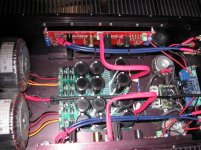Hi,
A friend of mine has a Aleph 5 clone that is producing a loud hum from the left channel mainly. The hum is not a low level type that while listening to music you don't really notice, it is louder.
Any idea what could be the problem?
I have attached some pictures of the amplifier.
Cambe
A friend of mine has a Aleph 5 clone that is producing a loud hum from the left channel mainly. The hum is not a low level type that while listening to music you don't really notice, it is louder.
Any idea what could be the problem?
I have attached some pictures of the amplifier.
Cambe
Attachments
if that's proper dual mono , something is faulty in that channel
there are NTCs from audio gnd to chassis?
there are NTCs from audio gnd to chassis?
Looks a bit dusty inside. How old is the amp, specifically the psu caps? Has it developed the hum over time? Could be dried out capacitors...
Zen Mod I will have to take another look at the amplifier and check for the NTCs audio ground to chassis ground.
Rodeodave my friend said he has had the amplifier 7 years. He is he second owner. Yes, the amplifier is quite dusty, I will try to clean some of it out when I go and check for the NTCs.
Rodeodave my friend said he has had the amplifier 7 years. He is he second owner. Yes, the amplifier is quite dusty, I will try to clean some of it out when I go and check for the NTCs.
Last edited:
Might not be dried out caps then.
Looks like there are 10R resistors between the psu ground and the chassis, to the left of the psu pcb in the second picture. Looks like mains earth ground (green wire) goes there too.
Looks like there are 10R resistors between the psu ground and the chassis, to the left of the psu pcb in the second picture. Looks like mains earth ground (green wire) goes there too.
What happens if you short the inputs? Try channels individually, and together. Are the small transformers for the protection circuitry? What are the blue and white twisted wires between the transformers?
Looks like the mains voltage is switched (delayed?) with relays. Maybe there's a temperature sensor on the other end of the twisted blue/white wires to check on the transformer temperature? Or maybe just a power indicator LED.
Why are there two coaxial cables (purple pairs) into each channel PCB?
Asked myself the same question. It looks like one cable goes from the RCA input to the pcb, and the other from the XLR to the pcb. It also looks like the XLR shield is not connected to the chassis. Maybe the amp was run off the RCA without grounding the negative input at the XLR?
The XLR (balanced stp) shield should connect to the Chassis/enclosure, not to the amplifier.Asked myself the same question. It looks like one cable goes from the RCA input to the pcb, and the other from the XLR to the pcb. It also looks like the XLR shield is not connected to the chassis. Maybe the amp was run off the RCA without grounding the negative input at the XLR?
For best high frequency attenuation the XLR shiled should connect to the chassis/enclosure at both ends, but if the user's internal interference is low then a one end connection for the shield is possibly good enough.
In the OP it was stated that one channel was worse than the other. I would swap over the cap boards to see if the fault moves to the other channel.
This would prove it was a PSU fault or a layout fault.
I would be surprised if the fault was a layout fault as it must have worked correctly at one time in its life ( or you would hope so ).
This would prove it was a PSU fault or a layout fault.
I would be surprised if the fault was a layout fault as it must have worked correctly at one time in its life ( or you would hope so ).
- Status
- Not open for further replies.
- Home
- Amplifiers
- Pass Labs
- Aleph 5 Hum Problem

